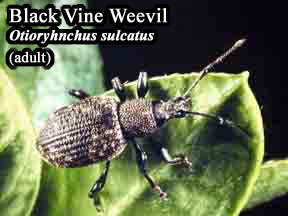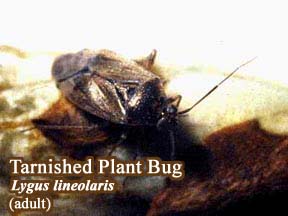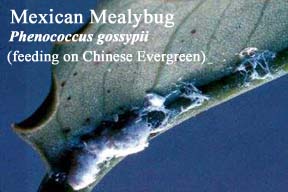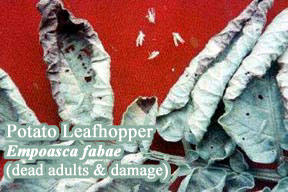Perennials
Plant Health Problems
Herbaceous perennial ornamentals are a diverse group consisting of about 2,500 species in approximately 500 genera. While there is a corresponding diversity in the diseases affecting these plants, some generalizations about common diseases can be made. Because these plants will be present for a number of years, and pathogens can build up over time, it is important to start by planting healthy vigorous plants. Avoid planting perennials which exhibit stunting, mottled or off-color growth, leaf spots, or obvious disease. Select disease-resistant cultivars where available. Water the plants until they become well established. Remove diseased debris in the fall and do not add diseased material to the compost pile. Reduce leaf wetness periods by watering the plants when the foliage is dry and with sufficient time to dry before nightfall. Space plants far enough apart to allow air circulation through mature plants. Remove weeds which can harbor diseases and reduce air circulation, and be careful with herbicides around the flower beds. For more information, see the factsheet on Identification and Management of Diseases of Perennials in the Landscape.
Diseases caused by Fungi:
Basal or root rot, Rhizoctonia solani or Pythium spp.
Roots and basal stems are rotted, black or brown and collapsed. Sunken lesions may occur at the soil line. These fungi must be distinguished microscopically. However, Pythium tends to predominate in wet soils and Rhizoctonia in well-drained soils.
Control with fungicides is not reliably effective and may be prohibitively expensive, so removal of infected plants is important.
Downy mildew, Peronospora, Phytophthora or Plasmopora spp.
These pathogens typically cause leaf spots with downy white or gray patches under the leaves. The downy growth results from the production of spores called sporangia which are wind-dispersed between plants. Disease is usually favored by cool wet weather.
Control may include cultural means of reducing humidity and leaf wetness. Control may also be achieved with the use of fungicides applied as soon as symptoms are visible. Among the compounds registered for use in Connecticut is mancozeb. Consult the label for dosage rates, safety precautions, and directions for use.
Gray mold, flower and leaf blight, Botrytis cinerea.
This fungus occurs everywhere and commonly infects senescing or damaged plant parts such as old flowers, causing a fuzzy gray mold. Spores are produced which are easily blown around. From these tissues the fungus moves into healthy stems and leaves, causing a damaging blight. Disease is favored by cool wet conditions and the presence of overripe fruit or old flower petals.
Sanitation is the most important means of control. Remove dead flowers before gray mold develops. If disease has moved into leaf or stem parts, control may also be achieved with the use of fungicides applied as soon as symptoms are visible. Among the compounds registered for use in Connecticut is thiophanate-methyl. Consult the label for dosage rates and safety precautions.
Leaf spots, Alternaria, Cercospora, Colletotrichum, or Septoria spp.
Leaf spots are very common, typically sharply delimited necrotic areas on plant leaves caused by a wide variety of pathogenic species. Leaf spots usually are favored by wet conditions and may become important if a large number of lesions are present or if they start to coalesce.
Under those conditions, control may also be achieved with the use of fungicides applied as soon as symptoms are visible. Among the compounds registered for use in Connecticut are thiophanate-methyl and sulfur. Consult the label for dosage rates and safety precautions.
Powdery mildew, Erysiphe, Sphaerotheca, Microsphaera, or Oidium spp.
These fungi are obligate plant parasites which grow vegetatively on the plant leaf surface, sending haustoria, structures which absorb food from the host, into epidemal cells. The white mildew seen on the leaf is a combination of vegetative mycelium and spores borne in chains on upright conidiophores. Wind-dispersed mildew spores can germinate without free water under high humidity conditions, and disease is often severe when conditions are humid but dry. Small black overwintering structures called perithecia are often found in powdery mildew affected areas.
Control may also be achieved with the use of fungicides applied as soon as symptoms are visible. Among the compounds registered for use in Connecticut are potassium bicarbonate, ultra fine oil, sulfur, triadimefon, or thiophanate-methyl fungicides. Consult the label for dosage rates, safety precautions, and directions for use.
Rust, Puccinia, Uromyces, or Aecidium spp.
The term rust refers to both the disease and pathogen causing the disease. Rust fungi are specialized obligate parasites which can cause disease on one (monoecious) or two (heteroecious) host species. Symptoms of rust infection include rust-colored spores or gelatinous horns in powdery pustules on leaves or stems. Surrounding tissue is discolored and yellowed, and plants are often stunted.
Control of heteroecious rusts may be aided by removal of the alternate host, but for most perennials, control may also be achieved with the use of fungicides applied as soon as symptoms are visible. Among the compounds registered for use in Connecticut are sulfur and mancozeb. Consult the label for dosage rates, safety precautions, and directions for use.
Smut, Entyloma spp.
Smuts are diseases caused by fungi. While most smut diseases attack the reproductive parts of plants such as flowers, replacing them with a sooty black mass of fungal spores, smut diseases of perennials often result in light spots on leaves and are called white smuts.
This disease is not typically serious, and usually can be controlled removal of infected plant debris.
Stem rot, Sclerotium rolfsii or Sclerotinia sclerotiorum.
Symptoms include yellowing of lower leaves followed by wilting and death of the rest of the plant. A white cottony mass of mycelium growing around the crown or on the soil near the crown distinguishes this crown rot from others. In this fungus web may be found the whitish to cream color or buff or reddish-brown seed-like sclerotia the size of a pinhead.
Control may include removing and destroying all infected plant parts and removal of top soil around the plant. New soil may replace sclerotia-filled soil.
Wilts, Fusarium oxysporum or Verticillium dahliae.
These pathogens infect the vascular or water-conducting tissues of plants, and cause wilt symptoms by impairing water flow. As a result, symptomatic plants may flag or wilt on one side of the plant, leaves may be twisted and yellow on one side, turn brown and hang down prior to drying up. Overall, the plant exhibits drought symptoms despite adequate soil moisture. If the stem is cut open near the base, the vascular tissues are typically brown or discolored.
Wilt control involves removal of infected plants and associated roots and soil. The pathogens survive in soil and plant debris for long times, so disposal of plants and soil without spread is important.
Diseases caused by Bacteria:
Bacterial soft rot, Erwinia carotovora.
The bacteria can enter plant tissues, including roots, bulbs, corms and tubers through wounds, causing a rapid, wet soft rot. Tissues become slimy and soft.
Control is best achieved by sanitation, planting healthy stock, drying propagation material, and avoiding physical wounding and insect damage.
Bacterial leaf spots, Pseudomonas or Xanthomonas spp.
Irregular water-soaked spots become brown or black. Leaves may turn yellow and drop.
Remove diseased plants and debris as noticed. Avoid overhead irrigation, especially in the evening and increase air flow through the plants to speed drying of the foliage.
Crown gall, Agrobacterium tumefaciens.
The bacteria which cause this disease instigate a rapid increase in unorganized plant cell division which results in a rough-surfaced gall ranging from almost indistinguishable up to several inches in diameter on roots, at the soil line or in shoot tissue.
Bacteria cannot live for more than a couple of years without a host, so removal of infected plants, rotation and inspection of planting stock is the most effective control of this disease.
Diseases caused by Phytoplasmas:
Aster yellows, phytoplasma.
The pathogen is a prokaryotic organism without cell walls. It infects the phloem of susceptible plants and causes a general yellowing and dwarfing symptom. The phytoplasma is spread by a leafhopper vector.
Infected plants should be removed and destroyed. Early season control of the leafhopper vector and removal of weed hosts may help prevent re-infection.
Diseases caused by Viruses:
Cucumber or Tobacco mosaic, Ringspot, or Tomato spotted wilt, viruses.
A number of different viruses can attack perennials. These viruses are obligate parasites which are not themselves alive, but use plant cell metabolism to replicate and produce more virus. Symptoms of infection are commonly loss or mottling of color, yellowing, yellow rings, stunting, and/or deformed leaves, flowers or buds. Viruses can be transmitted by mechanical means such as touching or rubbing leaves with hands or tools contaminated by contact with diseased plants, by dodder, nematodes, grafting or insects such as aphids, leafhoppers, whiteflies or thrips.
Control is based on starting with virus-free stock or seeds, control of insect vectors, eliminating weed virus hosts, resistant varieties, and eliminating diseased plants.
Diseases caused by Nematodes:
Foliar, stem, or bulb nematodes, Aphelenchoides or Ditylenchus spp.
These plant parasitic worms attack virtually all plant parts and may cause leaf lesions, yellowing, necrosis and leaf drop, bud malformation, plant stunting, stem swelling or galls, and secondary fungal infections of necrotic tissues. The nematodes live and move in water films.
Reducing leaf moisture and removal of infected tissues, debris or plants is important. Bulbs may be heat-treated to kill nematodes, but time and temperature combinations vary considerably between plant and nematode species.
Lesion nematodes, Pratylenchus penetrans.
These parasitic worms are quite common in a large number of plants. Sensitive plants may be stunted and appear off-color. Root symptoms often include an elliptical reddish-brown lesion about 1 mm long by 0.2 - 4 mm wide resulting from nematode infection and movement through the root cortex. The nematodes feed on root cells as they move along, causing cell death and the sunken lesion.
Root-knot nematodes, Meloidogyne hapla.
The northern root-knot nematode, M. hapla, is a sedentary endoparasite, meaning that it infects host roots after hatching from eggs, stimulating the formation of a small gall containing specialized feeding cells, and feeds in the same location through several molts to produce several hundred offspring. Because most of its life cycle is inside roots, it may be spread to new locations with vegetative propagation material. This nematode is parthenogenetic, a single female can reproduce without males, resulting in a new generation every 28 days under ideal conditions. The galls produced on roots interrupt translocation and act as a nutrient sink. As a result, plants may be stunted, wilt easily, and show signs of nutrient deficiency. The nematode has a wide host range, but a number of ornamentals, including Rudbeckia, Aster, and others, have been shown to be resistant.
Growing resistant plants or rotating to small grains can greatly reduce or eliminate nematode populations in infested soil.
Diseases caused by Physiological/Environmental Factors:
Dodder, Cuscuta spp.
Dodders are seed plants which do not produce chlorophyll and must therefore obtain food from other plants. These parasitic vines are leafless, yellow to orange in color, and wind around host plants, inserting structures called haustoria into the green plants to obtain nutrients. The vine stunts plant growth and makes a tangle of matted growth which chokes out a planting.
Removal of infested plants, and dodder plants prior to seed production is important.
Abiotic problems, include physical injuries such as winter injury or heaving, conditions of drought or too much water, herbicide damage and others.
Injuries typically occur in episodes, are uniform in distribution, and may affect more than one species. Disease problems generally continue over time, are clumped or limited in distribution, and occur on a single species.
Avoid injury by placing or seeding plants in locations suitable for the cultivar (soil type, shade/sun, etc.). Modify winter temperature fluctuations where appropriate by covering or mulching beds with a light material such as straw.
Insect Problems:
Aphids.
These are soft bodied, pear-shaped insects, from 1/16 to 1/8" (1.5 - 3 mm) long, whose identifying characteristic is the presence of cornicles, that look like paired tailpipes, on the top rear of the body. Antennae are usually shorter than or equal to the body in length. Winged forms may be produced when food is getting scarce or when it is necessary for the insects to disperse to an alternate host. They have piercing-sucking mouthparts and excrete honeydew, which supports black sooty mold. Ants often tend aphids to obtain honeydew, and may move aphids to uninfested plants. The green peach aphid and other aphids often infest anemone, arabis, cheiranthus, leopard's bane, and penstemon. Many naturally occurring insects prey upon aphids, including ladybeetles, lacewings, aphid predatory midges, syrphid flies, and tiny parasitic wasps. If given sufficient time, and not sprayed with broad-spectrum insecticides, these beneficial insects usually bring aphid populations under control. If needed, aphids may be controlled by spraying with insecticidal soap or ultrafine horticultural oil, which are registered for use against this pest in Connecticut and will conserve the beneficial insects. Repeat applications may be necessary. Imidacloprid applied as a drench to be taken up by the roots will provide season-long control of aphids. Consult the labels for dosage rates and safety precautions.
 Black vine weevil, Otiorhynchus sulcatus.
Black vine weevil, Otiorhynchus sulcatus.
The larvae of this weevil often injure perennials in nurseries and ornamental plantings by feeding on the roots. The grubs devour the small roots, chew the bark from the larger roots, often girdling them, or feed internally when crowns or corms are present. The tops of girdled plants first turn yellow, then brown, and the severely injured plants die. Leaf notching by adults can be unsightly. The 1/2" long adult weevil is black, with a beaded appearance to the thorax and scattered spots of yellow hairs on the wing covers. Only females are known. Adults are flightless and feed nocturnally. The legless grub is white with a brown head and is curved like grubs of other weevils. Adults and large larvae overwinter, emerging from May - July. The adults have to feed for 3-4 weeks before being able to lay eggs. Treating the soil with insect pathogenic nematodes may control the larvae and should be the first line of defense in landscape plantings. Acephate and fluvalinate are among the compounds registered for control of this pest in Connecticut, and may be applied when there is adult feeding and before they start laying eggs. The usual timing for these foliar sprays is during May, June and July at three week intervals. Insecticide resistance is very common; be aware that adults may appear to be dead following contact with fluvalinate, but may recover from poisoning within a few days. Consult the labels for dosage rates and safety precautions.
Flea beetles.
These are tiny black or brown jumping beetles that feed on the leaves of many plants, eating out small round holes from the underside, but leaving the upper epidermis unharmed. The remaining tissue soon dies, however, and falls away, leaving holes through the leaves that turn yellow, then brown and later die. They are not much more than 1/16" long. The insects live through the winter under rubbish and in other sheltered places, and in early spring may be found feeding on plantain and other weeds. They also feed on the leaves of apple, wild cherry, and maple. As soon as the preferred food, such as Shasta daisy or stock, appear in the garden or field, the flea beetles gather upon them. The overwintering beetles lay eggs in the soil in June. The larvae feed upon tubers and roots of the host plants. The larvae pupate and the adult beetles emerge early in July.
These beetles feed on perennials as long as the plants are green and temperatures are favorable. If flea beetles are controlled in the spring when they first begin feeding, fewer beetles will be present in the fall and the following spring. Among the compounds registered for control of this pest in Connecticut are rotenone or carbaryl applied as sprays or dusts to adults on the foliage. Consult the labels for dosage rates and safety precautions.
 Plant bugs.
Plant bugs.
The fourlined plant bug, Poecilocapsus lineatus and tarnished plant bug, Lygus lineolaris, lay eggs in soft stems of many plants. They hatch about the middle of May and the young bugs suck the sap from the tender leaves of perennials such as heuchera, aconitum, lavender and lupine. They molt five times and when mature, about the middle of June, they have wings and are nearly 1/3" long. The fourlined plant bug is yellow-green, marked lengthwise on the wings with four black stripes alternating with three green stripes. The injury to the leaves consists of sunken areas around the punctures. These areas later appear as circular transparent spots and finally as circular holes. The tarnished plant bug is mottled brownish, 1/5" long, with a yellow "Y" shape pattern on its back. There is one generation each year of the fourlined plant bug and two to five generations yearly of the tarnished plant bug. The nymphs can be managed by spraying with azadirachtin, ultrafine horticultural oil, insecticidal soap or malathion, which are among the compounds registered for control of this pest in Connecticut. Consult the labels for dosage rates, and safety precautions.
Meadow spittlebugs, Philaenus spumarius.
This sap sucking insect is more of a nuisance problem than a serious plant pest. The nymphs feed on herbaceous perennials, such as coreopsis and salvia, and some woody shrubs. This life-stage is the highly visible spittle mass. The nymphs produce a white, frothy covering as they feed on the succulent new growth. If the spittle is removed, the green nymph can be seen. The adults resemble large, compact brown leafhoppers and will quickly jump or fly if disturbed. If the population is high, the plant can suffer some discoloration and distortion. Carbaryl, chlorpyrifos and are registered for control of this pest in Connecticut. Imidacloprid, applied as a systemic taken up by the roots, will provide season-long control. Consult the labels for dosage rates, and safety precautions.
 Mealybugs.
Mealybugs.
Several species of mealybug, including the citrus and ground mealybugs, attack perennials; foxglove and heuchera are particularly susceptible. Mealybugs suck plant sap during all stages of plant growth, causing stunted growth and distorted leaves. White cottony masses appear on leaf surfaces, in leaf axils and sheaths. Among the compounds registered for control of this pest in Connecticut are malathion, insecticidal soap or ultra-fine horticultural oil, which require contact with the insect to give good control. Imidacloprid, applied as a systemic taken up by the roots, will provide season-long control.. Ants tend mealybugs to harvest their honeydew, and sometimes move mealybugs to uninfested plants. Ants may also protect sucking insects from their predators and parasites, so ant control should be considered as an important component in managing mealybugs.
 Potato leafhopper, Empoasca fabae.
Potato leafhopper, Empoasca fabae.
This leafhopper will feed on such perennials as aster, astilbe and dahlia. This insect is a serious pest in some years in Connecticut. It does not overwinter here, and the severity of infestation depends on the size of the migrating population and the weather. In addition to being a pest of perennials, it also feeds on potatoes, beans and alfalfa. The adult is about 1/8 " long and yellowish green. Nymphs are similar in color but have no wings. Both adults and nymphs are difficult to see because they move rapidly. Adults and nymphs cause injury by sucking sap from the bottom side of leaves. This causes the young leaves to curl or gives them a white peppered appearance. Continued feeding results in a yellowing or browning of the leaves, called "hopperburn." Imidacloprid, applied as a soil drench, will provide systemic, season-long control. Among the compounds registered for control of this pest in Connecticut are pyrethrum, rotenone, or carbaryl. Repeated use of insecticides may lead to outbreaks of aphids. Consult the labels for dosage rates and safety precautions.
Thrips, Frankliniella spp.
Thrips suck sap from both the foliage and flowers of a wide variety of perennials. These small whitish insects feed on pollen and flower petals. The adults may have wings equal or greater than the body length. The four wings are veinless with long hairs on the leading and trailing edge. They quickly scurry into hiding when the plant is touched or they sense changes in the environment. A sign of their presence is pollen spread downward from the anthers, spoiling the blooms. This is more noticeable on the darker-colored flower forms. Thrips are readily detected by exhaling on a blossom held over your hand, or tapping the blossom onto a white sheet of paper. The carbon dioxide in the breath will cause the thrips to exit the bloom and fall into your hand.
Control begins with buying clean plants and if needed, handpicking of infested blossoms. For commercial growers, spinosad is an effective material to control flower thrips. Consult the labels for dosage rates and safety precautions.
Twospotted spider mites, Tetranychus urticae.Spider mites have eight legs in the adult stage and spin silk. They reproduce quickly in hot, dry conditions, feeding on the undersides of leaves. Symptoms are a yellow stippling of leaves and a generally unhealthy appearance. When the infestation is severe, webbing may encase the plant. At this point, it's very hard to get miticides through the webbing. Among the compounds registered for control of this pest in Connecticut are insecticidal soap and ultrafine horticultural oil. Spraying with insecticidal soap can give sufficient control if applied at least twice at 7-10 day intervals. The predatory mite, Neoseiulus fallacis, is most commonly found feeding where there are mite infestations. A single application of ultrafine horticultural oil (1/2 - 1% dilution) can be effective if predatory mites are present. Special care should be taken with soap or oil to obtain thorough spray coverage, because they only work on contact. Hexythiazox or abamectin (a restricted use product) are appropriate for commercial growers. Consult the labels for dosage rates and safety precautions. Avoid applying carbaryl or pyrethroids, which tend to be much more toxic to the predators than to the pest spider mites.
Slugs.
Garden slugs, molluscs without a shell, sometimes infest moist, shaded gardens. Hostas are particularly attractive to slugs. Slugs feed mostly at night, rasping holes in tender leaves or along leaf margins. Recent slug damage is easily recognized by looking for the slimy, iridescent trail left by their crawling. At maturity they can be up to four inches long. They lay clusters of eggs, encased in slime, in the fall. Slugs can be controlled by lightly cultivating the ground in the spring to destroy dormant slugs and their eggs. A band of diatomaceous earth put around new plantings will control slugs by rupturing their epidermis. During the day, slugs hide in dark and moist places, so they can be trapped by placing a small board in the flower bed for them to hide. Scrape the slugs off the board and into soapy water to kill them. A bowl of beer, sunk into the ground with a roof of some sort, will act as a bait and the slugs will drown. Metaldehyde bait is registered for control of this pest in Connecticut. Consult the label for dosage rates, and safety precautions.
White grubs.
Bergenia, foxglove, heuchera are all perennials whose roots are attacked by these grubs. Adults, which are beetles, feed on the foliage. See Lawns, oriental beetle.

